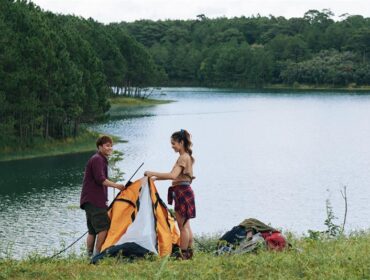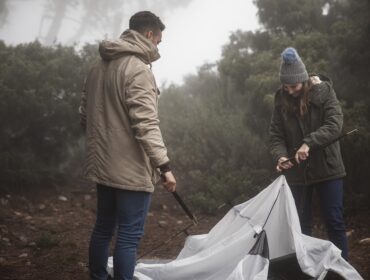Winter is finally in full swing and much of the country has already experienced big, winter storms that have catapulted the winter sports season into full gear. While many outdoor enthusiasts head to the slopes, there are those who prefer the quiet of winter camping. While it can offer its challenges, winter camping in the backcountry can be incredibly beautiful and rewarding. To encourage some backcountry winter adventures, we’ve created this essential winter camping gear list, with winter camping-specific gear that will make your experience a great one.
Before we begin, I do have a quick note about safety. Winter landscapes, while beautiful, can be dangerous and even deadly in the winter. You don’t want to put you and your party at risk by attempting a winter camping trip without adequate preparation.
Now, let’s get started!
Winter Camping & Sleeping Essentials
- Four season/winter tent: It’s important to have a durable, weatherproof, winter/four season tent that can handle the cold environments and harsher conditions, with plenty of space for gear.
- Cold-weather sleeping bags: Cold-weather sleeping bags are an absolute necessity for winter camping, to keep your body warm and comfortable when sleeping or resting in your tent. A sleeping bag rated 0F° or lower is recommended. Both the Marmot Trestle 0F° and Mountain Hardwear Bozman 0F° are great options.
- Insulated sleeping pads: You could be sleeping snow or very cold ground, so an insulated sleeping pad is essential — alongside a cold-weather sleeping bag.
- Camp chairs: When you’re not in your sleeping bag, you’ll want a place to lounge and relax out of the snow or off cold surfaces. Camping chairs provide that — perfect for cooking, campfires, and more.
- Camping blankets: For an added layer of comfort and warmth, it’s good to always bring a compressible, packable blanket for your tent or around the campfire. Rumpl offers some of the best in the industry, with Original Recycled Insulation, NanoLoft, and Down options for optimum warmth and compressibility
Backcountry Communication
- A satellite GPS communicator, like the Garmin GPSMAP 66i allows for quick and easy communication while in the backcountry. This is in case of emergency situations where rescue or assistance is needed. It’s a necessity in all four seasons, but especially in winter, when the weather can be much more severe.

Avalanche Safety Gear (One Per Group)
If you are planning on doing any winter camping out west, an avalanche kit is highly recommended. Avalanches are not just a danger for skiers or snowboarders. It can happen in seconds without warning. Having an avalanche kit can save your life, and is a must for any mountain winter camping. This includes items like a:
- Avalanche Transceiver
- Avalanche Probe
- Snow Shovel
- Slope Meter
- Snow Saw
Extra Batteries and Power
Always bring extra batteries for headlamps, and pack several power sources like portable power banks. Electronics don’t mix well with the cold and you’ll always want to have your phone or communication device available at all times.
Food and Water Essentials
- A large cooking pot for food or to melt snow
- Extra propane fuel, for cooking and back up, additional warmth
- An insulated water reservoir, to protect your water from freezing
- Warm food and drink options like coffee, tea, or hot chocolate
- Extra food and snacks, for emergencies and bad weather situations
Heat Options
- Firestarter, matches, lighter
- Hand and foot warmers
Winter Clothing
- Baselayers: Look for synthetic or natural fibers like wool, with heat retention and moisture wicking properties
- Midlayer: A layer like a fleece or insulated piece usually is a great midlayer for extra warmth
- Shell or outer layer: A waterproof, windproof, and overall weatherproof, sealed outer layer or shell is the final top layer that protects your other layers from being compromised. It should keep the cold and wet out but still be breathable enough to let heat and moisture escape.
- The essential, smaller cold-weather items like a balaclava, beanie, gloves, and warm crew socks–multiple pairs, in case your feet get wet or you want to double up–go a long way in keeping your extremities and face warm and frostbite-free.
Check out more information on layering your hiking clothes in this article.
Winter Boots and Snow Shoes:
- Winter Boots: To protect your feet from getting cold and wet, you’ll need waterproof, insulated high-rise winter boots.
- Snowshoes: If you want to avoid postholing and struggling to hike through deep snow, snowshoes are a must. They help keep you and your gear above the surface of the snow, and are essential for backcountry winter camping. Atlas Run Snowshoes, Atlas BC-Helium Run Snowshoes, and Tubbs Frontier Snowshoes are all great options.

Ski or Trekking Poles
Ski or trekking poles with large snow baskets help with balance and staying above the snow surface when hiking through deep sections of a trail.
Sun Protection
We tend to attribute sun protection with warmer weather, but it’s equally as important in the snow and winter season. Snow reflects the sun’s harmful rays, which can cause severe sunburn, and if you don’t have adequate eye protection, like goggles or sunglasses, you suffer from snow blindness, after exposure from too much ultraviolet light. So always wear mineral-based sunscreen and bring a good pair of polarized sunglasses or ski goggles, so you avoid the painful, lingering consequences in the future.
Article by Nathan Lee Allen
Nathan Lee Allen is a storyteller and photographer from Kentucky. Check out his work on his website nathanleeallen.com, on Facebook.com/peaktopierglobalstudio, and Instagram @nathanleeallen.




